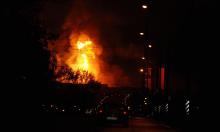Breathing Fresh Air Can Be Extremely Dangerous
Everyone knows that the air in metropolises is contaminated. Yet, scientists believe that the quality of air in Siberia or in the Far East of Russia is no better than, say, in Moscow. Simple breathing can be dangerous. Recently, ozone made it to the black list. Now, think twice before you breathe in that fresh smell after a thunderstorm.
Here is the list of the major air contaminators:
- Suspended Particles
These are particles smaller than 10 microns - dust, soot and smoke.
Suspended matters form during combustion of nearly any type of fuel as well as during soil drainage. In the cities, these particles are the main reason for smog.
Suspended matters may be both nearly harmless and extremely hazardous, depending on chemical compounds settling on the particles’ surface. Respiratory passages suffer from dust and soot the most, while development of other diseases is also possible, including heart diseases and cancerous tumors. Suspended particles are especially dangerous when the air contains excessive amounts of nitrogen and sulfur oxides.
- Sulphur Dioxide (SO2)
This is a gas that, when combined with water in the air, forms sulfurous acid. As a result, the areas where a great deal of SO2 is emitted into the air have frequent acid rains harmful for plants and soil microorganisms. Sulphur dioxide is hazardous for people as well, especially those suffering from lung and bronchus diseases.
Within the recent years the levels of dioxide in Europe, the USA and Russia have dropped significantly and continue dropping. Higher levels of dioxide are observed in the areas where power stations, boiler rooms and smelters use coal as a fuel. The largest amounts of SO2 are registered in Norilsk, where average concentration exceeds the admissible limit value nearly three-fold.
- Nitrogen Oxide (NOx)
This chemical is released during combustion at high temperatures, for example, in car engines, at power station and factories. Same as sulphur dioxide, nitrogen oxide causes acid rains.
Besides, this chemical participates in chemical reactions involving the sun light. As a result, even more dangerous toxins are released along with heavy smog. The air contaminated with nitrogen oxide turns brownish-black.
Even low concentration of nitrogen oxide causes interrupted breathing and cough. Children raised in the areas with high concentration of NOx frequently suffer from serious respiratory tract diseases.
- Carbon Oxide (CO)
This is the most familiar compound. It is a product of incomplete fuel combustion mostly released by cars. It lingers in the air for approximately a month, and then oxidized to form a relatively harmless CO2. Carbon oxide decreases the ability of blood to transfer oxygen for a long time. As a result, the heart and brain suffer from oxygen deficit.
- Ozone (O3)
We all know that ozone forms a protective layer nine to 30 miles above the Earth’s surface, keeping the planet from the dangerous Sun. Yet, ozone located relatively low lacks this protective function. On the contrary, it is a strong oxidizer, dangerous for plants and animals. Affected by ozone, humans suffer from serious burns of the respiratory tract mucosa coat. Children who spend the summer in cities with hot climate suffer from ozone the most.
The largest concentrations of ozone are observed in the cities. Exhaust contains high quantities of light organic matters and nitrogen oxide, the building blocks of ozone that forms during hot weather and sunny days. Later, ozone mixes with the air and travels long distances with the wind.
- Lead (Pb)
Lead gets into the human body with air, food and water. It also settles on dust particles and is stored in blood, bones and soft tissues. Lead causes serious kidney, liver, nervous system and other organs diseases. It also causes psychological disorders, fits and mental retardation, especially in children.
For many decades, lead was thrown into the atmosphere along with exhausts of leaded gasoline. In Russia, production of leaded gasoline was banned in 2003, which caused a significant decrease in concentration of lead in the atmosphere.
Like other heave metals, lead penetrates plants, so people should be careful when burning fallen leaves, because the dangerous toxin will get back into the air.
- Volatile Organic Matters
These compounds, that include benzene, formaldehyde, and 1,3 - butadiene, form during incomplete combustion of car fuel or evaporation of petroleum, oil and lubricants. Even relatively small concentrations may cause cancer, cardiovascular diseases and liver and kidney malfunction. They may also cause congenital deformities and infertility.
Volatile organic matters easily enter into chemical reactions with oxygen and other oxidizers, releasing even more dangerous toxins.
- Toxic Matters
They include compounds that cause serious harm to plants and animals even in trace amounts. The American Clean Air Act lists 188 of such matters released by industrial facilities, 21 matters in car exhaust and 33 compounds typical for the city air.
Most toxins are cancerogenic and cause DNA damage. They are particularly harmful when settled on the surface of suspended particles.
It was recently discovered that mutations caused by toxins can even be inherited. Considering small concentration, it is impossible to reveal toxins without special equipment. Yet, toxins concentration is one of the main criteria for assessing ecological environment.
Liliana Lokatskaya
Medpulse
Subscribe to Pravda.Ru Telegram channel, Facebook, RSS!




